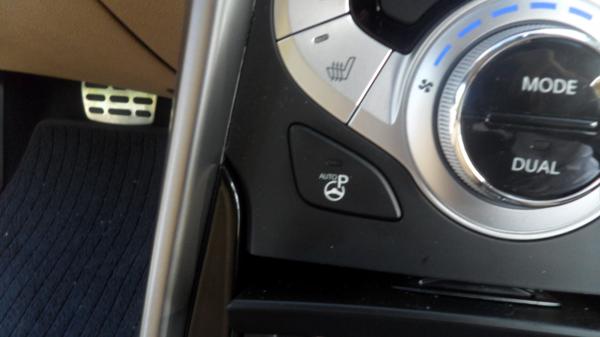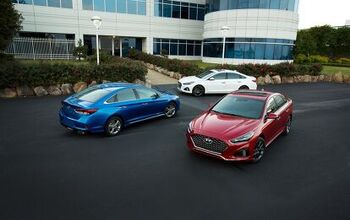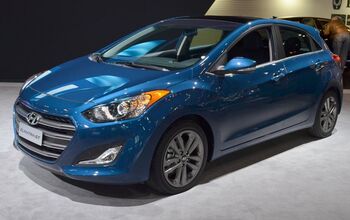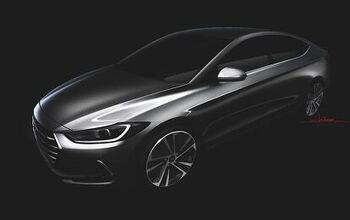Is Hyundai's New Avante (Elantra) An Autobot?
No, this has nothing to do with a Hollywood blockbuster… we think the new Avante/Elantra could be the first self-parking mass-market compact car. Take a closer look at the now infamous video clip of men in suits trying to park the next-generation Hyundai Avante. The first 20 seconds clearly show the driver’s hands on the steering wheel. After that however, the audience never gets a clear view of the cockpit. Someone is either obstructing the camera or the scene cuts away. When we do happen to catch a glimpse of the steering wheel (at 00:25 for example), it appears to move on its own. Granted, the driver could be grasping the wheel at the six o’clock position, out of view of the camera, but I think there’s something more to the situation than that.
Second, if these suits can’t park, then why was the parking space made so small? It looks to be just a few inches larger than the car itself. Surely the people who staged the event would want to stroke the egos of their bosses and make a parking spot big enough for an Equus. This point is especially true given that the video looks to be shot in Korea where the concept of “saving face”, especially for high-level executives, is alive and well.
Third, what’s so special about a bunch of the top brass trying to parallel park the company’s newest offering anyway? Why are so many people gathered to watch something as mundane as parking? When the big bosses are invited to drive the car, it’s usually to showcase the latest and greatest technology, not to have them do their best parking valet impressions. I can’t imagine Bob Lutz leaving his plush air-conditioned office to go parallel park a Cruze unless there was a damned-good reason to do so.
The answer to all these questions, at least as these three images suggest, is that the car in the video was parking itself!
The first image clearly shows a button marked with a steering wheel icon, the word “auto”, and the letter “P”. On its own, this picture could just imply an automatic electronic parking brake. However, the second and third pictures suggest more. The second image shows a diagram of a vehicle using front-mounted sensors to identify a parking space and then back into it. The third image shows sensors on the front bumper of new Avante. The Korean text on the second image reads as follows:
Panel 1: Ultrasonic sensors detect an empty parking space
Panel 2: The car parks itself when drivers remove their hands from the wheel
A recent Korean television advertisement from Hyundai’s parts manufacturing affiliate, Hyundai Mobis adds to my Avante Autobot theory. The ad shows a driver having difficulty trying to parallel park her car. “Autobots, roll out!” The car then proceeds to measure the parking space using front-mounted sensors (much like in the second and third images above) and then park itself.
The 15-second ad is available here. The self-parking fun starts at 00:09. The Korean voice-over roughly translates to:
Parking is not something for people to know, it is something for cars to do.
The Korean text on the screen during the self-parking reads:
More by Walter Foreman
Latest Car Reviews
Read moreLatest Product Reviews
Read moreRecent Comments
- SCE to AUX "discounts don’t usually come without terms attached"[list][*]How about: "discounts usually have terms attached"?[/*][/list]"Any configurations not listed in that list are not eligible for discounts"[list][*]How about "the list contains the only eligible configurations"?[/*][/list]Interesting conquest list - smart move.
- 1995 SC Milking this story, arent you?
- ToolGuy "Nothing is greater than the original. Same goes for original Ford Parts. They’re the parts we built to build your Ford. Anything else is imitation."
- Slavuta I don't know how they calc this. My newest cars are 2017 and 2019, 40 and 45K. Both needed tires at 30K+, OEM tires are now don't last too long. This is $1000 in average (may be less). Brakes DYI, filters, oil, wipers. I would say, under $1500 under 45K miles. But with the new tires that will last 60K, new brakes, this sum could be less in the next 40K miles.
- BeauCharles I had a 2010 Sportback GTS for 10 years. Most reliable car I ever own. Never once needed to use that super long warranty - nothing ever went wrong. Regular maintenance and tires was all I did. It's styling was great too. Even after all those years it looked better than many current models. Biggest gripe I had was the interior. Cheap (but durable) materials and no sound insulation to speak of. If Mitsubishi had addressed those items I'm sure it would have sold better.





































Comments
Join the conversation
I have no doubt this is an automatic parking system. Still, won't be the first mass-market offer of such a system... The feature for automatic parallel parking has been available on the european Touran since 2007, on the Golf since 2008 and on the Passat (don't know since when). The function of parking in a space vertical to the street has been added with the upgraded Touran recently and will be available on the coming Sharan. Again, nothing new in mass-market cars. IIRC the VW System was heavily developed with (by?) Valeo, so it might actually be the same one as used by Hyundai. The way it supposedly works seems quite similar, as does the used button... ;)
can i ask why Hyundai are using Jaguar XJs as test vehicles??? That is an XJ with the 4ws system?